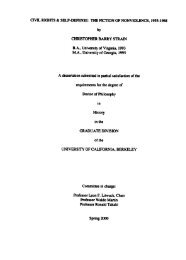Negro Digest - Freedom Archives
Negro Digest - Freedom Archives
Negro Digest - Freedom Archives
You also want an ePaper? Increase the reach of your titles
YUMPU automatically turns print PDFs into web optimized ePapers that Google loves.
ployment rate for black youth between<br />
16 and 19 was 26 percent,<br />
more than twice the rate for white<br />
youth .<br />
Between 1960 and 1966, there<br />
were substantial increases in the<br />
number of black people holding<br />
white collar positions, and less dramatic<br />
but still increases for blacks<br />
holding blue collar positions . The<br />
increase in white collar employment<br />
shows the largest gain in clerical<br />
and sales positions . Blacks are<br />
still under-represented in the skilled<br />
white collar positions, as of 1966,<br />
with the situation for black males<br />
and black females showing some<br />
significant differences . In professional<br />
and technical positions black<br />
males represent 42 percent as<br />
many as there would be if there<br />
were full occupational equality,<br />
while females in the same category<br />
represent 58 percent as many as<br />
would be found in a situation of full<br />
equality. On the other hand, in the<br />
clerical positions black males represent<br />
89 percent as many as<br />
would be found in a situation of<br />
full equality while black females<br />
comprise only 39 percent. These<br />
and other data which we have analyzed<br />
indicate that the black female<br />
has a better chance of obtaining a<br />
job consistent with her education<br />
and training than the black male in<br />
the professional, technical and<br />
managerial categories, while black<br />
males are more likely than females<br />
to be adequately represented in<br />
clerical positions .<br />
NEGRO DIGEST March 1968<br />
(Continued on page 84)<br />
The chronic problems black people<br />
face with education, employment,<br />
and occupational levels are<br />
reflected in the income levels of the<br />
population, although the Sixties<br />
have seen changes in income for<br />
blacks . There are varying interpretations<br />
of income changes in the<br />
black community and they produce<br />
different conclusions . Some analysts<br />
talk about the income of families,<br />
while others talk about the<br />
income of persons, and then differentiate<br />
between males and females .<br />
Furthermore, income changes can<br />
be analyzed in terms of the percentage<br />
change in median income, the<br />
ratio of black to white median income,<br />
or the absolute black-white<br />
differences in income. Let us see<br />
how the black situation in the Sixties<br />
stands up in terms of all these<br />
measurements .<br />
In 1960, 68 percent of all black<br />
families had incomes under $5,000<br />
per year (36 percent of all white<br />
families were at this level), but by<br />
1966 this had declined to 56 percent<br />
of all families ( 27 percent<br />
for whites) . The proportion of<br />
black families with incomes between<br />
$5,004 and $10,000 went up<br />
from 27 to 33 percent (white families<br />
declined from 46 to 44 percent),<br />
between 1960 and 1966 .<br />
Black families with incomes over<br />
$10,000 went up from 6 to 12 percent<br />
in the same period of time<br />
(with a corresponding increase<br />
from 18 to 30 percent for white<br />
families) . These figures are ad-<br />
3 1
















